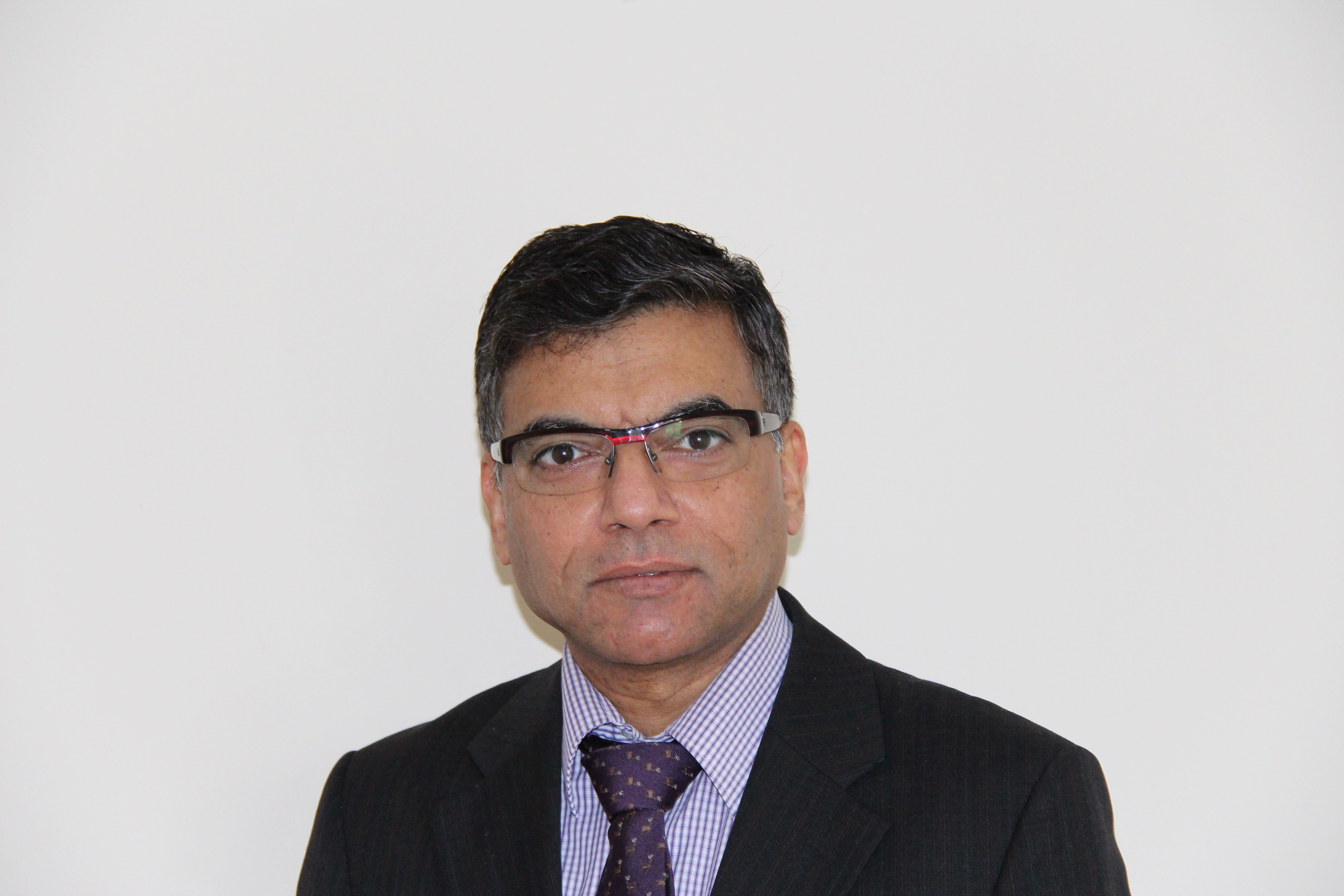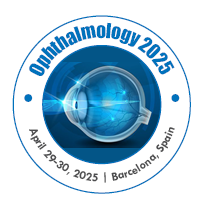Sessions/Tracks
Cataract surgery has undergone significant advancements over the years, improving both patient outcomes and surgical efficiency. The introduction of phacoemulsification, a minimally invasive technique, allows surgeons to break down cataracts using ultrasound waves, significantly reducing recovery time. Moreover, the development of advanced intraocular lenses (IOLs) provides patients with options for correcting astigmatism and presbyopia, leading to enhanced visual outcomes. Femtosecond laser technology has also revolutionized the procedure by offering precision in corneal incisions and lens fragmentation, further minimizing complications. Innovations such as real-time imaging systems assist surgeons in navigating complex cases with greater accuracy. Postoperative care has improved through the use of topical anaesthetics and advanced anti-inflammatory medications, promoting quicker recovery and less discomfort. As research continues, future innovations may include artificial intelligence to predict surgical outcomes and personalized lens designs tailored to individual eye conditions. Overall, these advancements not only enhance the surgical experience but also ensure that patients enjoy a higher quality of vision post-surgery, marking a significant leap forward in the field of ophthalmology.
Artificial intelligence (AI) is transforming the landscape of eye diagnostics by enabling faster, more accurate assessments of various eye conditions. AI algorithms analyse vast datasets, learning to identify patterns and anomalies that may escape the human eye. This technology is particularly valuable in detecting diseases such as diabetic retinopathy, glaucoma, and age-related macular degeneration at earlier stages. For instance, AI-powered imaging systems can evaluate retinal scans in seconds, providing ophthalmologists with detailed analyses that enhance decision-making. Moreover, AI can streamline workflows in clinics, reducing the burden on healthcare providers while improving patient throughput. Machine learning models are also being trained to predict disease progression, allowing for timely interventions tailored to individual patients. Furthermore, the integration of AI into telemedicine platforms offers remote diagnostic capabilities, bridging gaps in access to care, especially in underserved areas. As AI continues to evolve, its role in eye diagnostics is expected to expand, leading to personalized treatment plans and improved patient outcomes. Ultimately, AI not only augments the diagnostic process but also holds the potential to revolutionize the entire approach to eye care.
Glaucoma is a progressive eye disease characterized by damage to the optic nerve, often associated with increased intraocular pressure. It is one of the leading causes of irreversible blindness worldwide, making early detection and timely treatment crucial. Regular eye examinations, including measuring intraocular pressure and assessing the optic nerve's health, are essential for identifying at-risk individuals. Screening methods such as visual field tests and optical coherence tomography (OCT) allow for the early detection of glaucomatous changes before significant vision loss occurs. Treatment options range from topical medications to lower intraocular pressure to surgical interventions for advanced cases. Emerging therapies, such as minimally invasive glaucoma surgery (MIGS), offer promising alternatives with quicker recovery times and fewer complications. Additionally, patient education on risk factors—such as family history, age, and diabetes—empowers individuals to seek timely care. Ongoing research into genetic markers and neuroprotective agents holds promise for future therapeutic strategies. By prioritizing early detection and tailored treatment plans, we can significantly reduce the burden of glaucoma and preserve vision for millions.
Retinal imaging technology has seen remarkable advancements, enhancing our ability to diagnose and monitor various ocular conditions. Techniques such as optical coherence tomography (OCT) provide high-resolution cross-sectional images of the retina, allowing for detailed visualization of its layers. This precision aids in detecting diseases like diabetic retinopathy, age-related macular degeneration, and retinal detachment at their earliest stages. Fundus photography has also improved with digital imaging, offering clearer images that can be easily shared among specialists for collaborative care. Additionally, the development of auto fluorescence imaging allows for the assessment of metabolic changes in retinal pigment epithelium, providing insights into early disease processes. Innovations like wide-field imaging capture extensive areas of the retina in a single shot, crucial for patients with peripheral retinal conditions. Furthermore, advancements in artificial intelligence facilitate automated analysis of retinal images, improving diagnostic accuracy and efficiency. These technological strides not only enhance our understanding of retinal diseases but also promote timely interventions, ultimately leading to better patient outcomes and preserved vision.
In our increasingly digital world, eye care has become more important than ever, especially for tech users. Prolonged screen time can lead to digital eye strain, characterized by symptoms like dry eyes, blurred vision, and headaches. To mitigate these effects, the 20-20-20 rule is a practical guideline: every 20 minutes, take a 20-second break to look at something 20 feet away. This simple practice helps reduce eye fatigue and refocuses vision. Additionally, adjusting screen brightness and contrast can create a more comfortable viewing experience, while using blue light filters can decrease exposure to potentially harmful light emitted by screens. Keeping the workspace well-lit and maintaining an appropriate distance from the screen can further alleviate strain. Regularly blinking helps keep the eyes moist, reducing dryness. Furthermore, routine eye exams are essential, as they allow for early detection of potential issues related to screen usage. By adopting these eye care tips, tech users can protect their vision and ensure a more comfortable digital experience, paving the way for healthier habits in an age dominated by technology.
In the digital age, screen time has become ubiquitous, leading to increased reports of eye strain and discomfort. Regularly taking screen breaks is essential for maintaining eye health and overall well-being. Continuous exposure to screens can cause digital eye strain, characterized by symptoms such as dryness, irritation, and blurred vision. The body’s natural response to prolonged focus is fatigue, and without adequate breaks, this can lead to long-term discomfort. The 20-20-20 rule is an effective strategy: every 20 minutes, look away from your screen at something 20 feet away for at least 20 seconds. This simple practice helps relax eye muscles, reducing strain. Additionally, incorporating longer breaks into your routine, such as stepping away from your computer or engaging in non-screen activities, can provide significant relief. Creating a balanced environment by ensuring proper lighting and ergonomics also contributes to comfort. Ultimately, prioritizing eye rest and incorporating breaks into our daily routines not only enhances productivity but also protects against the adverse effects of our increasingly screen-focused lifestyles.
Telemedicine has ushered in a new era in ophthalmology, revolutionizing how eye care is delivered and accessed. This approach allows patients to receive consultations, diagnoses, and even follow-up care remotely, significantly improving access, especially for those in rural or underserved areas. Through secure video conferencing and remote monitoring technologies, ophthalmologists can assess a patient's condition without the need for an in-person visit, saving time and resources. Telemedicine has proven particularly beneficial for managing chronic conditions like glaucoma or diabetic retinopathy, where regular monitoring is crucial. Moreover, the use of artificial intelligence in telemedicine platforms enhances diagnostic accuracy, allowing for timely interventions. Patients can upload images of their symptoms, which can be reviewed by specialists, leading to faster diagnosis and treatment plans. The pandemic accelerated the adoption of telehealth services, proving its efficacy and convenience. However, challenges remain, including ensuring comprehensive eye examinations and addressing technology access disparities. As telemedicine continues to evolve, it promises to play a critical role in shaping the future of ophthalmic care, making eye health more accessible to everyone.
Dry eye disease (DED) is a common and often debilitating condition affecting millions worldwide. It occurs when the eyes do not produce enough tears or when the tears evaporate too quickly, leading to discomfort and potential damage to the ocular surface. Common causes include prolonged screen time, environmental factors like wind and smoke, certain medications, and underlying health conditions such as autoimmune diseases. Symptoms can range from mild irritation to severe discomfort, impacting daily activities. Management strategies for dry eye disease are multifaceted. Artificial tears are often the first line of treatment, providing lubrication to relieve symptoms. For more severe cases, prescription medications like cyclosporine. A can help increase tear production. Lifestyle modifications, such as using humidifiers, wearing sunglasses outdoors, and practicing the 20-20-20 rule during screen time, can also alleviate symptoms. Additionally, procedures like punctual plugs can help retain tears on the eye's surface. Regular follow-ups with an eye care professional are essential for monitoring the condition and adjusting treatment plans as needed, ensuring that patients can maintain comfort and protect their vision.
Blue light, a high-energy visible light emitted by digital screens and artificial lighting, has raised concerns regarding its impact on vision and eye health. While blue light is part of the natural light spectrum and helps regulate our circadian rhythms, excessive exposure—especially from screens—can lead to digital eye strain and disrupt sleep patterns. Symptoms of overexposure include dry eyes, fatigue, and difficulty focusing. Research suggests that prolonged blue light exposure may contribute to retinal damage over time, potentially increasing the risk of conditions like age-related macular degeneration. However, conclusive evidence regarding its long-term effects is still under investigation. To mitigate these risks, many individuals are turning to blue light blocking glasses and screen filters, which claim to reduce exposure. Additionally, employing good screen habits—such as the 20-20-20 rule and maintaining appropriate screen brightness—can further protect eye health. Furthermore, ensuring proper lighting in workspaces can help reduce glare. As our reliance on digital devices continues to grow, understanding and managing blue light exposure will be vital in safeguarding our vision and overall well-being.
Maintaining optimal eye health requires a holistic approach that extends beyond regular eye exams and vision correction. A balanced diet rich in nutrients essential for eye health plays a pivotal role. Foods high in omega-3 fatty acids, such as fish, as well as leafy greens, carrots, and fruits rich in vitamins C and E, can help prevent age-related macular degeneration and dry eye syndrome. Staying hydrated is equally crucial, as it supports tear production and overall ocular health. Regular physical activity promotes circulation, which is beneficial for maintaining healthy eye function. Additionally, practicing good screen habits like taking frequent breaks and ensuring proper lighting can alleviate digital eye strain. Mindfulness practices, such as yoga and meditation, can help reduce stress, which may indirectly benefit eye health. Incorporating protective eyewear when exposed to bright sunlight or hazardous environments is also vital. Furthermore, quitting smoking and managing systemic health conditions can significantly contribute to long-term eye health. By embracing a comprehensive lifestyle approach, individuals can better safeguard their vision and enhance their overall quality of life.
The future of contact lenses is being reshaped by innovative smart technology that enhances user experience and offers new functionalities. Unlike traditional lenses, smart contact lenses are designed to integrate technology directly with the eye, potentially revolutionizing how we monitor and manage vision. These lenses can feature embedded sensors capable of monitoring glucose levels for diabetic patients, providing real-time health data without the need for finger pricks. Additionally, augmented reality (AR) lenses are being developed to overlay digital information onto the real world, creating immersive experiences for users in various fields, from gaming to navigation. Furthermore, advancements in materials and designs aim to improve comfort and oxygen permeability, reducing the risk of dryness and irritation. Research is also underway to develop lenses that can change tint in response to light levels, offering UV protection and enhancing visual comfort. As these technologies evolve, they promise to redefine the functionality of contact lenses, making them not just vision correction tools but also vital health monitoring devices that enhance quality of life.
Corneal transplantation, is a surgical procedure that involves replacing a damaged or diseased cornea with healthy donor tissue. This procedure can restore vision for patients suffering from conditions like corneal scarring, keratoconus, or corneal dystrophies. There are several techniques for corneal transplantation, with being the traditional method that replaces the entire cornea. However, newer techniques like and focus on replacing only the affected layers, leading to faster recovery and reduced risk of complications. These advanced procedures typically involve less surgical trauma and a quicker return to visual function. Outcomes of corneal transplantation are generally favourable, with many patients achieving significant improvements in vision. The success rate varies depending on factors such as the underlying condition, patient age, and the presence of other eye diseases. Ongoing research into tissue engineering and bioengineering aims to improve donor tissue availability and enhance the success of corneal transplants. As techniques evolve, corneal transplantation continues to offer hope for restoring sight to those with severe corneal conditions.
Ocular pharmacology is an evolving field that focuses on the development and application of medications specifically for eye health. Recent advancements have introduced innovative therapies aimed at treating a variety of ocular conditions. One significant development is the introduction of sustained-release drug delivery systems, such as intravitreal implants, which provide continuous medication for conditions like age-related macular degeneration and diabetic retinopathy. These implants minimize the need for frequent injections, improving patient compliance and outcomes. Additionally, novel topical medications, including new classes of anti-inflammatory and anti-allergic agents, have been designed to enhance efficacy while minimizing side effects. The use of biologics, such as monoclonal antibodies, is also gaining traction for targeting specific pathways in diseases like uveitis and retinal disorders. Furthermore, research into gene therapy holds promise for treating hereditary eye diseases by addressing the underlying genetic causes. As our understanding of ocular pharmacology deepens, the potential for personalized medicine in ophthalmology grows, paving the way for targeted treatments that enhance vision and overall eye health.
Integrative approaches to eye health emphasize the connection between lifestyle, nutrition, and overall well-being in maintaining optimal vision. A holistic perspective recognizes that factors such as diet, exercise, stress management, and preventive care play crucial roles in eye health. Nutrient-rich foods, particularly those high in antioxidants, omega-3 fatty acids, and vitamins A, C, and E, can help protect against age-related macular degeneration and other ocular diseases. Regular physical activity enhances blood circulation, supporting overall eye function. Additionally, stress-reduction techniques like yoga and mindfulness can alleviate tension that may contribute to eye strain and discomfort. Incorporating regular eye exams into one’s healthcare routine is essential for early detection and intervention of potential issues. Integrative eye care also includes using protective eyewear in harmful environments and minimizing screen time to reduce digital eye strain. By combining conventional treatments with lifestyle modifications, patients can foster a more comprehensive approach to eye health. This integrative perspective not only enhances visual function but also promotes overall health and quality of life, making it an essential component of modern eye care
The connection between systemic health and vision is increasingly recognized in ophthalmology, highlighting how overall health impacts eye conditions. Various systemic diseases can have direct effects on ocular health. For instance, diabetes is closely linked to diabetic retinopathy, a leading cause of blindness. Poor blood sugar control can damage the blood vessels in the retina, leading to vision loss. Similarly, hypertension can result in hypertensive retinopathy, causing changes in the retina that may affect vision. Autoimmune diseases, such as rheumatoid arthritis or lupus, can lead to dry eye syndrome or uveitis, resulting in discomfort and potential vision impairment. Moreover, lifestyle factors like smoking, obesity, and sedentary behaviour contribute to conditions that negatively affect both systemic and ocular health. Conversely, certain eye conditions can indicate systemic health issues, prompting further medical evaluation. Regular comprehensive eye exams are crucial for early detection of both ocular and systemic diseases, allowing for timely interventions. Understanding this connection empowers patients to adopt healthier lifestyles that benefit both their eyes and overall health, fostering a proactive approach to wellness.
As technology becomes an integral part of daily life, awareness of digital eye strain is more critical than ever. This condition arises from prolonged screen use, leading to symptoms such as dryness, blurred vision, and discomfort. With the average person spending several hours daily on computers, smartphones, and tablets, the risk of developing digital eye strain has escalated. Factors contributing to this issue include improper lighting, screen glare, and inadequate blinking during screen time. To combat digital eye strain, individuals should prioritize regular breaks using the 20-20-20 rule, ensuring their eyes can relax and refocus. Adjusting screen settings like brightness and contrast and using anti-glare screens can further alleviate discomfort. Maintaining an ergonomic workspace, including proper screen height and distance, is essential for comfort. Additionally, hydration and proper nutrition can play a role in supporting eye health. Educating oneself about the signs of digital eye strain and adopting proactive measures can significantly reduce its impact. By promoting awareness, we can foster healthier habits in an increasingly digital world, ensuring our eyes remain comfortable and functional.
Age-related macular degeneration (AMD) is a leading cause of vision loss in older adults, affecting the macula, the central part of the retina responsible for sharp, detailed vision. AMD primarily manifests in two forms: dry and wet. Dry AMD is characterized by the gradual thinning of the macular tissue, while wet AMD involves the growth of abnormal blood vessels beneath the retina, leading to leakage and scarring. Risk factors for AMD include age, genetics, smoking, and prolonged sun exposure. Early stages may not present noticeable symptoms, making regular eye exams crucial for early detection. Patients may experience blurred vision, difficulty reading, or distorted images as the disease progresses. While there is no cure for AMD, certain interventions can help manage the condition. Lifestyle changes, such as a diet rich in leafy greens, antioxidants, and omega-3 fatty acids, may slow disease progression. Additionally, vitamins and supplements specifically formulated for eye health can be beneficial. For wet AMD, treatments such as anti-VEGF injections can help reduce vision loss. Ongoing research aims to improve understanding and develop new therapies for AMD, providing hope for better management and preservation of vision.
As the global population ages, vision care for older adults has become an increasingly important public health focus. Aging is associated with a variety of ocular changes and conditions, including cataracts, glaucoma, age-related macular degeneration (AMD), and diabetic retinopathy. These conditions can significantly impact quality of life, affecting the ability to perform daily activities, maintain independence, and engage in social interactions. Regular eye examinations are crucial for early detection and management of these age-related eye diseases. Moreover, advancements in treatment options have improved outcomes for many patients. For instance, cataract surgery is one of the most common and successful procedures among older adults, restoring vision and enhancing daily functioning. Additionally, managing chronic conditions such as diabetes and hypertension is vital, as they can exacerbate ocular issues. Education on eye health, including the importance of a nutritious diet and protective eyewear, is essential for promoting healthy vision in aging populations. By prioritizing comprehensive eye care, we can improve the overall well-being of older adults, ensuring they maintain their vision and independence as they age.
Optical coherence tomography (OCT) is a ground-breaking imaging technology that has revolutionized the field of ophthalmology. This non-invasive technique provides high-resolution cross-sectional images of the retina, enabling clinicians to visualize its layers in remarkable detail. OCT plays a crucial role in diagnosing and monitoring various ocular conditions, including age-related macular degeneration, diabetic retinopathy, and glaucoma. By allowing for early detection of subtle changes in retinal structure, OCT helps guide timely treatment interventions, ultimately preserving vision. The technology has evolved significantly, with advancements like spectral-domain OCT offering even greater resolution and speed. Furthermore, OCT angiography provides insights into retinal blood flow without the need for dye injections, enhancing patient safety and comfort. As OCT continues to advance, its applications are expanding into other areas of eye care, including anterior segment imaging and assessing corneal conditions. Ongoing research aims to improve imaging techniques and develop predictive algorithms for disease progression. Overall, OCT represents a vital tool in modern ophthalmology, enhancing diagnostic accuracy and shaping the future of eye care.
Patient-centred care in ophthalmology emphasizes the importance of involving patients in their treatment decisions, tailoring care to their individual needs and preferences. This approach fosters a collaborative relationship between patients and healthcare providers, enhancing overall satisfaction and outcomes. By actively engaging patients in discussions about their conditions, treatment options, and potential risks, ophthalmologists can empower them to make informed choices about their eye health. This includes providing clear explanations of diagnoses and procedures, as well as considering patients' unique lifestyles and concerns. Furthermore, implementing shared decision-making tools and educational resources can enhance patient understanding and involvement. Patient-centred care also recognizes the emotional and psychological aspects of vision loss, offering support services to address these challenges. Additionally, ensuring accessibility and accommodating diverse populations, including those with language barriers or disabilities, is crucial for effective care delivery. As the healthcare landscape evolves, prioritizing patient-centred care in ophthalmology can lead to improved adherence to treatment plans, better health outcomes, and a more positive experience for patients navigating their eye health journeys.
Environmental factors play a significant role in influencing eye health, impacting individuals of all ages. Exposure to harmful UV rays from sunlight can lead to conditions such as cataracts and macular degeneration, highlighting the importance of wearing protective eyewear outdoors. Furthermore, air pollution has been linked to various ocular issues, including dry eye syndrome and allergic conjunctivitis. Pollutants can irritate the eyes, leading to inflammation and discomfort. Indoor environments also affect eye health; prolonged exposure to screens without adequate lighting can contribute to digital eye strain. In addition, factors like humidity levels and the use of air conditioning or heating can impact tear film stability, exacerbating dry eye symptoms. Lifestyle choices, such as smoking and diet, further influence eye health; a diet low in antioxidants may increase the risk of age-related eye diseases. Awareness of these environmental factors is crucial for preventive care. By adopting protective measures, such as wearing sunglasses, maintaining good indoor air quality, and ensuring proper screen ergonomics, individuals can mitigate the impact of environmental influences on their eye health.
Refractive surgery has evolved dramatically over the past few decades, providing patients with effective solutions for vision correction. Initially, procedures like radial keratotomy (RK) were the primary options, using surgical incisions to reshape the cornea. However, advancements in technology have led to the development of more precise and safer techniques, notably. LASIK utilizes laser technology to reshape the cornea with minimal discomfort and a quick recovery time. The introduction of femtosecond lasers has further enhanced the safety and accuracy of these procedures. In recent years, the emergence of advanced methods such as PRK (Photorefractive Keratectomy) and SMILE (Small Incision Lenticular Extraction) has expanded options for patients with varying eye conditions. These techniques cater to individuals with thinner corneas or those who may not be suitable candidates for traditional LASIK. Moreover, personalized treatments using wave front technology allow for tailored corrections based on individual visual aberrations. As research continues, the future of refractive surgery looks promising, with ongoing innovations likely to enhance efficacy, safety, and patient satisfaction.
Ethics in vision science research is a critical consideration that shapes the integrity and applicability of scientific findings. As research in ophthalmology and vision science expands, it is essential to ensure that studies are conducted with the utmost respect for participants' rights and well-being. Informed consent is a cornerstone of ethical research, requiring that participants fully understand the purpose, risks, and benefits of their involvement. Additionally, researchers must consider the potential impacts of their findings on public health and policy, striving to avoid biases and conflicts of interest that could undermine trust in the scientific process. Issues of equity and access are also paramount; research should be designed to be inclusive and representative of diverse populations, ensuring that findings are applicable across different demographics. Furthermore, the use of animal models in vision research raises ethical questions about the treatment and welfare of these subjects. As the field continues to evolve, fostering a culture of ethical rigor and transparency is vital to advancing knowledge while maintaining public confidence in vision science.
Global perspectives on eye health highlight the disparities and challenges faced by populations around the world. Vision impairment and blindness disproportionately affect low- and middle-income countries, where access to eye care services is often limited. The World Health Organization recognizes that approximately 2.7 billion people globally suffer from some form of vision impairment, with a significant percentage living in regions with inadequate resources for prevention and treatment. Initiatives like the Vision 2020 program aim to address these disparities by promoting awareness, improving access to services, and training healthcare providers. Cultural factors also play a role in how communities perceive eye health and seek treatment, necessitating culturally sensitive approaches to care. Furthermore, global health challenges, such as aging populations and rising rates of non-communicable diseases, increase the demand for comprehensive eye care. Collaboration among governments, NGOs, and healthcare providers is essential to develop sustainable strategies that prioritize eye health as part of overall health care systems. By understanding and addressing these global challenges, we can work toward a future where quality eye care is accessible to all, regardless of geographic or economic barriers.
Emerging trends in ophthalmic devices are reshaping the landscape of eye care, enhancing diagnostic accuracy and treatment efficacy. Innovations such as portable diagnostic devices enable eye examinations in remote or underserved areas, increasing access to essential care. For instance, handheld fundus cameras allow healthcare providers to capture retinal images in various settings, facilitating early detection of conditions like diabetic retinopathy. Additionally, advances in smart wearable technology, such as smart contact lenses, promise to monitor health metrics continuously, offering real-time data for managing conditions like diabetes. Digital therapeutics are also gaining traction; these software-based solutions provide personalized interventions for conditions like dry eye disease and glaucoma management. Furthermore, robotic-assisted surgery is becoming more prevalent, improving precision in complex procedures such as cataract surgery and retinal repair. These trends are supported by the integration of artificial intelligence, which enhances diagnostic capabilities and treatment planning. As technology continues to evolve, the future of ophthalmic devices holds great promise for improving patient outcomes, streamlining care delivery, and addressing the growing global burden of eye diseases.




















